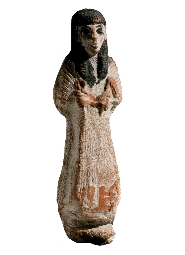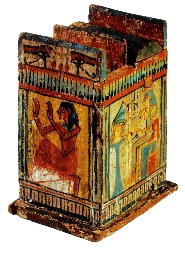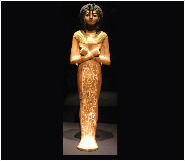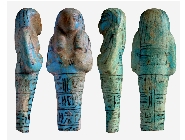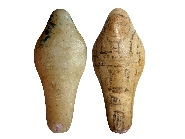

|
|
|||||||||||||||||||||
|
2181 BC
|
2040
|
1782
|
1570
|
1070
|
525
|
332
|
30 BC
|
|
|||||||||||||
|
|
|||||||||||||||||||||
|
|
|
||||||||||||||||||||
|
|
|||||||||||||||||||||
|
|
|||||||||||||||||||||
|
New Kingdom
In the New Kingdom (1570-1070 BC), during the reign of Tuthmosis IV (1419-1386
BC) of the 18th Dynasty, the role of
shabtis changed. They were then regarded as deputies for the deceased. Agricultural
implements were now included as part of their iconography, either painted
directly onto the figure or incorporated in the modelling. These implements
include a pick, a hoe, seed baskets, water pots carried on a yoke, and
sometimes brick moulds. Many of the figures are inscribed with the
shabti spell stipulating their agricultural duties. The shabtis were often made in stone or wood, the latter sometimes with attractive
polychrome decoration similar to coffins of the period. The use of faience
increased in popularity.
During the brief interlude in the New Kingdom known as the Amarna Period
(1350-1334 BC) Akhenaten introduced a new monotheistic religion based on the
worship of the sun disc, the Aten. The few surviving
shabtis for private persons have softer features reflecting the more restrained art of
the time. Akhenaten
’s shabtis, mostly fragmentary, show they were not provided with agricultural tools.
Instead he chose the ankh-sign, symbol of life, or the crook and flail, symbols
of kingship. The king is not regarded as an Osiris in the inscriptions. Some
private
shabtis are inscribed with a unique formula invoking the Aten through which resurrection
was to be obtained. However, they still retain the more usual implements. Thus
the role of
shabtis at this time is not clear. It was Tutankhamen who was responsible for
reinstating the old religious ideology of earlier times.
By the early 19th Dynasty a new type of figure was introduced alongside the
other
shabtis. These show the deceased wearing the dress of daily life with the
characteristic short-sleeved tunic, kilt and triangular apron. They wear a
bipartite or duplex wig
(1). The number of shabtis placed in burials gradually increased during the New Kingdom and reached
perhaps as many as 10 by the early 19th Dynasty with the number increasing
still further thereafter. Wooden
shabti boxes or pottery shabti jars were introduced as a means of storing the figures in the tomb. The wooden
boxes were often beautifully painted
(2).
Although no royal shabtis have been found before the reign of Ahmose, the first king of the 18th Dynasty
(1570-1546 BC), it is evident that royal burials contained a considerably
larger number of
shabtis than the nobility. 88 shabtis made in a variety of materials were found in the
tomb of Amenophis II. About 60
shabtis are known for Amenophis III and there are numerous fragments of shabtis for Akhenaten. Tutankhamen was buried with 417 shabtis, including many of
outstanding quality
(3). Seti I appears to have had in excess of 700 shabtis, the largest number for a New Kingdom pharaoh, although the majority of these,
made in wood, are fairly rudimentary in their execution
(4).
A group of shabtis peculiar to the New Kingdom, 20th Dynasty are those referred to as ‘contours perdus,’ literally meaning ‘lost contour’. They are always made of alabaster and often have details added in coloured
wax. Their shape is always very simple and the feet taper to a point. Several
of the Ramesside kings had this type of
shabti, including Ramesses IV (5), V, VII, IX and X. The simplistic outline and shape, even in royal examples,
probably reflects the general decline in Egypt following the reign of Ramesses
IV when the country became unstable with a succession of weak rulers. Other
shabtis of this type are also found for private individuals and there are also
anonymous examples.
|
|
||||||||||||||||||||
|
|
|||||||||||||||||||||
|
1. Polychrome terracotta shabti for S-?? wearing the dress of daily life
New Kingdom, 19th Dynasty
c. 1185-1070 BC
ex Gustav Moustaki collection
|
|
||||||||||||||||||||
|
|
|||||||||||||||||||||
|
|
|||||||||||||||||||||
|
|
|||||||||||||||||||||
|
2. Polychrome wooden shabti box for Pa-en-pa-khenty
New Kingdom, 19th Dynasty
c. 1293-1185 BC
ex Horace Owen collection
|
|
||||||||||||||||||||
|
|
|||||||||||||||||||||
|
Photo: Bob Partridge
Editor, Ancient Egypt magazine
|
|
||||||||||||||||||||
|
|
|||||||||||||||||||||
|
|
|||||||||||||||||||||
|
|
|||||||||||||||||||||
|
3. Wood with gold foil shabti for Tutankhamen
From Thebes, Valley of the Kings
(KV 62)
New Kingdom, 18th Dynasty
c. 1334-1325 BC
|
|
||||||||||||||||||||
|
|
|||||||||||||||||||||
|
|
|||||||||||||||||||||
|
|
|||||||||||||||||||||
|
|
|||||||||||||||||||||
|
4. Fragmentary faience shabti for Seti I
Probably from Thebes, Valley of the Kings (KV 17)
New Kingdom, 19th Dynasty
c. 1291-1278 BC
ex Gustav Moustaki collection
|
|
||||||||||||||||||||
|
|
|||||||||||||||||||||
|
|
|||||||||||||||||||||
|
|
|||||||||||||||||||||
|
5. Alabaster ‘contours perdus’ shabti for Ramesses IV with details added in black painted and wax
Probably from Thebes, Valley of the Kings (KV 2)
New Kingdom, 20th Dynasty
c. 1151-1145 BC
|
|
||||||||||||||||||||
|
|
|
|
|
|
|
|
|
|
|
|
|
|
|
|
|
|
|
|
|
|
|




























